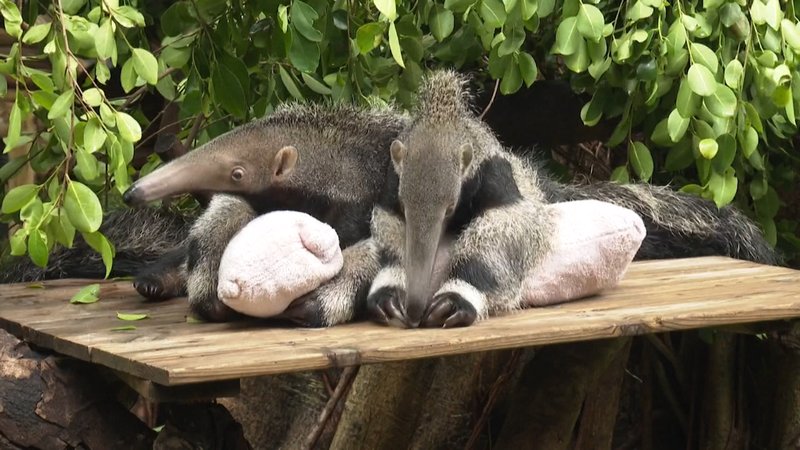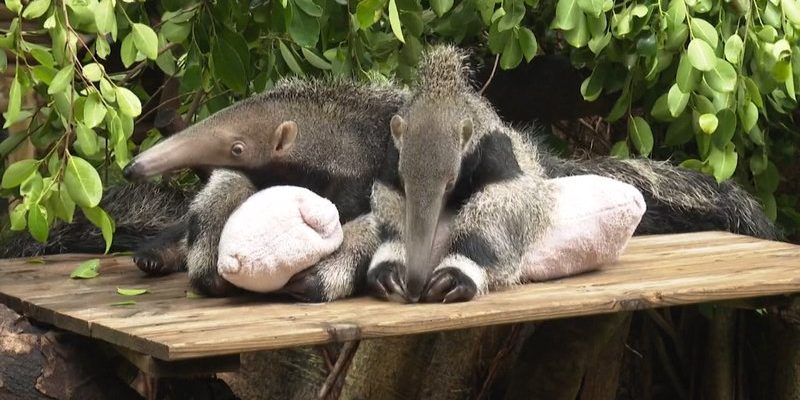
So, how do these unique animals manage to scrape by where many others might struggle? Let’s dive into the fascinating world of giant anteaters and discover their secrets for survival. From their diet to their behavior, there’s so much to uncover about how these gentle giants make their homes in tough landscapes.
Adaptations for a Specialized Diet
One of the most remarkable things about giant anteaters is their diet. They primarily feast on ants and termites, which are abundant in certain environments but can be hard to find in others. Here’s the thing: instead of having a standard set of teeth, giant anteaters use their long, sticky tongues to reach deep into insect mounds. Their tongues can extend up to 2 feet long! Imagine sticking your tongue out to grab a snack, but your snack is hiding in a tiny hole in the ground.
These anteaters use their powerful front claws to dig into ant hills or termite mounds, making it easier to access their meals. Interestingly, a giant anteater can consume up to 30,000 insects in a single day. The sheer efficiency of this method allows them to thrive even when food isn’t plentiful.
Another benefit of their unique diet is that ants and termites are relatively high in protein and low in fat. This means that giant anteaters can survive on a diet that might not provide a lot of calories, but it gives them the nutrients they need to keep going.
Surviving in Diverse Habitats
Giant anteaters are found across a variety of environments, from tropical forests to dry savannas. This flexibility is another key to their survival. They can adapt to both lush and arid regions, which not many animals can do. You might be wondering how they manage to do this.
In the thick forests, they can find plenty of ants and termites, while the grasslands offer open spaces for foraging. What’s interesting is how they manage moisture in different climates. In humid areas, their thick fur helps to keep them warm and dry, while in drier regions, they seem to thrive despite limited water sources. A giant anteater can lose a lot of water through their skin, but they also have a low metabolic rate, which means they don’t require as much water compared to other mammals.
This adaptability is crucial, especially as environmental conditions shift due to climate change. By being able to live in various habitats, giant anteaters have a better chance of finding food and shelter, which is essential for their continued survival.
Behavioral Adaptations
Behavior plays a huge role in how giant anteaters survive in tough environments. They are mostly nocturnal, which means they’re active at night. This not only helps them avoid the heat of the day but also allows them to sneak up on their food more easily. Imagine trying to eat dinner when it’s really hot outside: you’d probably not want to do that!
When faced with threats, these anteaters don’t run away like many other animals. Instead, they often stand their ground. Their sharp claws can be a formidable defense—if they feel threatened, they’ll use them to fend off attackers. This behavior is particularly effective in areas where predators are fewer, giving them a chance to stay safe and protect themselves.
You might also notice that they’re not very social animals. They prefer a solitary lifestyle, which means they don’t have to compete for resources like food or shelter. This way of living allows them to conserve energy and focus on finding their next meal.
The Role of Fur in Temperature Regulation
You might have noticed that giant anteaters have shaggy, coarse fur. This isn’t just for show! Their fur serves several practical purposes. First, it acts as insulation. In cooler climates or during chilly nights, their fur helps to keep their body temperature stable. It’s almost like wearing a cozy sweater, making it easier to survive in varying weather conditions.
Moreover, their fur is also designed to repel water. This is handy in wet environments where rain is frequent. By keeping their bodies dry, they reduce the risk of skin infections or other health issues that can arise from constant moisture. Plus, the light coloration of their fur can help camouflage them in certain environments, blending in with the grass or foliage and making it harder for predators to spot them.
It’s fascinating how something as simple as fur can play such a critical role in an animal’s survival strategy. In harsh environments, where every advantage counts, even something small can make a big difference.
The Importance of Habitat Preservation
As unique as giant anteaters are, they’re not without challenges. Habitat loss due to agriculture, deforestation, and urban expansion threatens their populations. Preserving the areas where they live is vital for their survival. You might think, “What can I do about that?” Well, there’s a lot of awareness and conservation work happening right now.
Organizations dedicated to wildlife conservation are working to create protected areas where giant anteaters can thrive without the pressure of human encroachment. This involves educating local communities about the importance of these creatures, which in turn helps to foster coexistence. When people understand the role of giant anteaters in the ecosystem—like controlling insect populations—they’re more likely to support their preservation.
By supporting conservation efforts, whether through volunteering or simply spreading the word, you can help ensure that these remarkable animals continue to survive in their harsh environments for generations to come.
Giant anteaters are truly remarkable creatures. Their unique adaptations—ranging from specialized diets and behavioral strategies to the critical role their fur plays—allow them to thrive in tough environments. The way they navigate their world is a great reminder of nature’s complexity and resilience.
As we continue to learn about these fascinating animals and the challenges they face, it’s essential to spread awareness and support efforts to protect their habitats. After all, every little bit helps in ensuring that the giant anteater can continue its role in the ecosystem, one sticky tongue at a time. So next time you think about these gentle giants, remember their strength lies not just in their size, but in their ability to adapt and survive in a constantly changing world.

